Connecting an electric boiler to a gas boiler: the best schemes and work procedures
Thinking of improving an autonomous hot water system to ensure a stable temperature of hot water? You must admit that it’s not pleasant to let out liters of water in anticipation of hot water, or to burn yourself when one of the households opened the tap while you are in the shower.
We will help you solve the problem of temperature differences, which pesters almost all users of double-circuit boilers and gas water heaters. We will tell you how to connect the boiler to a gas boiler. This solution will ensure the supply of hot water at a constant temperature, and the recirculation system eliminates the need to lower the first portion into the sewer.
Next, we will tell you how to implement this correctly and what connection schemes exist, and highlight their main advantages and disadvantages.
The content of the article:
Why connect the boiler to the boiler?
Flowing gas water heaters - boilers and columns - are very economical and efficient. They instantly heat up exactly the volume of water that is needed, and just when it is needed, without spending energy to maintain heat. Such efficiency and profitability made such equipment very popular.
However, they also have disadvantages that significantly reduce the comfort of use. Considering that you pay utility bills once a month, and use hot water every day, these flaws noticeably spoil the overall impression.
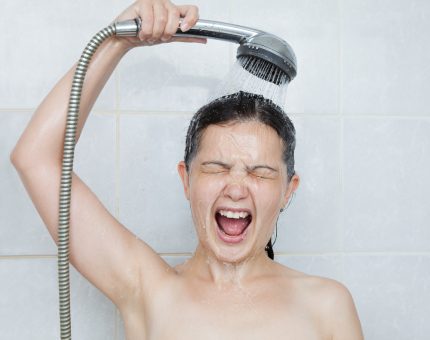
If you live alone, you may not notice this, but in a large family this feature will deliver a lot of unpleasant moments.
For any user, an unpleasant feature will be the inability to adjust a thin stream of warm water - the heating simply will not turn on when the pressure is too low. As a result, you will have to open the crane harder, spending excess water and filling the sewer.
In addition, an inexpensive two-circuit low-power boiler can quite cope with the heating of a small house - but it can not provide hot water with a strong pressure. You will either have to put up with the coolness of a large stream and the weak pressure of hot water, or purchase a more expensive model that will cope well with water supply, and will work for heating for a small fraction of its capabilities.
High-efficiency boilers, on the contrary, have problems with low pressure: their heat exchanger manages to bring a thin stream of water to a boil, and in order to avoid this, the boiler begins to cycle. This means that it alternates between very short periods of work and downtime, constantly turning on and off. As a result, the temperature of the tap water fluctuates significantly, and the boiler quickly generates its resource and consumes more gas for constant ignition.
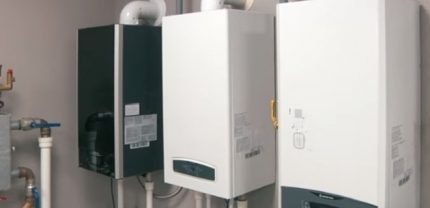
All these, as well as some disadvantages of the hot water supply system through a gas-fired gas water heater, can be leveled by including in this system, as a storage tank, a boiler. It will always have a supply of water evenly warmed up to the desired temperature, while the energy for heating it will hardly be used.
The Benefits of Combining Systems
The inclusion of an electric boiler in a gasified DHW system provides a number of advantages and new features:
- Constant temperature water supply, regardless of the number of taps open at the same time.
- Temperature stability, regardless of pressure - at least drop by drop, even with a powerful stream, the water will be hot enough, but not boiling water.
- System optimization, reduction of gas, water, sewage.
- The ability to install a double-circuit boiler of lesser power and cost - one that is enough for heating housing.
- Saving the resource of the boiler subject to the competent construction of the system.
- The ability to provide both heating and domestic hot water through a single-circuit gas boiler with minimal energy consumption.
- In summer, you can turn off the gas boiler, and heat the water with an electric boiler heater, while maintaining the resource of expensive equipment.
- The presence of two water heaters eliminates the inconvenience during the repair or annual maintenance of one of them.
Such a number of positive aspects will convince almost every user, because connecting a boiler to a gas flow water heater solves almost all of its problems, while retaining the advantages.
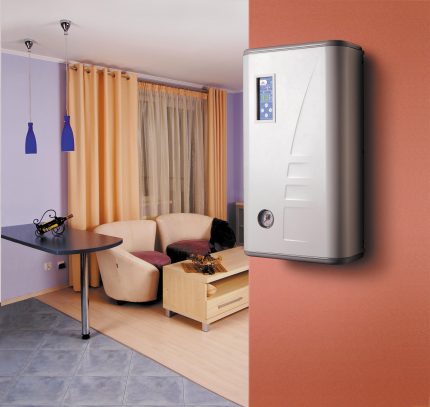
However, the inclusion of a boiler in the DHW circuit also creates some difficulties - we will talk about them later.
Challenges and weaknesses of the solution
Firstly, the number of connections, cranes and additional equipment is increasing, which does not add reliability to the system. Each twisted thread or tap is a potential leak point that needs regular inspection and inspection. In addition, the installation of an additional tap, valve, pump and meter pipe increases the total amount of the estimate.
Secondly, the boiler itself needs annual maintenance, and in some versions of the system it wears out more actively than during normal operation. At the same time, no one canceled the annual service of the boiler.
Thirdly, such an advantage of gas systems as compactness is lost: in conjunction with a boiler, even a small double-circuit boiler, connected correctly, will require a lot of space.
In addition, you will need the services of another specialist who will correctly perform equipment binding and wiring of heating and water supply.
Options for the interaction of the boiler and boiler
Connecting an electric boiler to a heating gas boiler is a very non-standard solution, caused mainly by the desire to reduce the cost of installing the system.
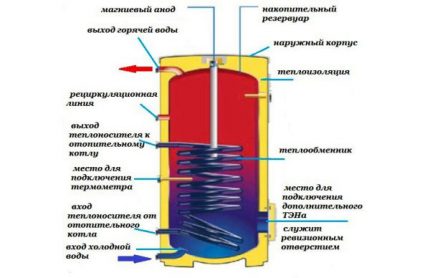
Such a system does not use electricity at all to heat water, but the road is in the installation and does not make it possible to save hot water by shutting down the boiler. Therefore, skilled craftsmen have learned to use ordinary electric boilers, which in essence are a huge thermos with a built-in boiler and temperature regulator.
Scheme # 1 - through a three-way valve
This option of connecting the gas boiler and boiler through three-way valvePerhaps the simplest, most obvious and widespread. It allows you to organize hot water supply even from a single-circuit gas boiler, saving on electricity.
The essence of the method is that an installed tee valve with a temperature controller redirects the flow of hot water either to the DHW circuit or to the heating circuit. The boiler automatics controls it: as soon as the water reaches the set temperature in the tank, the valve turns off the supply of hot water to it. At the same time, the boiler almost constantly works for heating, and for the short period that the water in the boiler is replaced, the batteries do not have time to cool down.
However, if you have a large family or have a huge Jacuzzi bathtub, a high-power boiler is required for the system to work effectively. Otherwise, after using a large volume of water in the house it will become noticeably cooler, and hot water will begin to flow into the batteries only after it has filled the boiler. Thus, water supply is a priority in such a scheme.

Also, through a three-way valve, you can organize bypassThen, under given conditions, it will direct the flow of hot water back to the boiler instead of radiators and other elements of the heating system. This will add security and ease of maintenance.
Scheme # 2 - through two independent pumps
Next, we will figure out how to independently connect the boiler to a dual-circuit gas boiler, using a circuit with two circulation pumps. Such a system is the most difficult to install, but also quite convenient to use. Due to the constant circulation of water in both circuits, hot water will flow immediately from the tap, it will not need to be drained, and heating also works constantly, regardless of the use of hot water.
One pump is necessary for the movement of water along the heating circuit. At the same time, the system is closed, special additives can be added to the liquid to extend the service life of the equipment - it will not get into the water supply. Almost all double-circuit boilers are equipped automation, and this pump is built into them. If your boiler does not have it, or you use a single-circuit boiler and a gas column separately, the installation of such a pump is necessary for high-quality heating.
The second pump provides recirculation in the hot water system. It is installed after all points of water intake, and after it, the water, which has cooled slightly after passing through the pipeline, returns to the boiler to repeat its path until someone opens the tap.
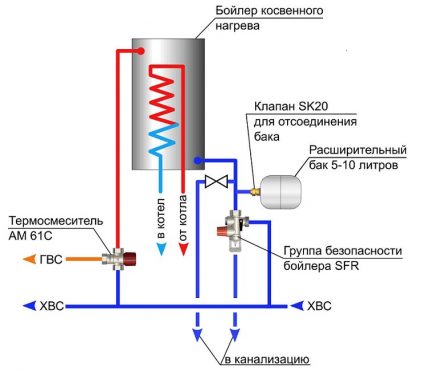
The recirculation supply is connected through a three-way valve at the inlet to the boiler, where the cold water supply is usually connected, and in the case of a connection with the boiler, already heated water.
Scheme # 3 - through the hydraulic arrow
A hydraulic distributor is necessary to balance the speed and pressure of water in different circuits so that the boiler and pumps can run smoothly. In fact, it is a tank with two or more inlets and outlets through which flows can both pass in parallel, independently, if their pressure is the same, and mix until a balance is established.
Instead of a ready-made, factory-made hydraulic pump, sometimes a pipe section is mounted at the boiler outlet 2 to 3 times the diameter, into which cuttings of a normal diameter to various devices cut into. At the same time, if the system is overloaded, and the pressure of hot water that the boiler gives out is not enough, the water from the return, already somewhat cooled, is mixed into the supply line.
If, on the contrary, the boiler performance is excessively high, part of the hot liquid immediately returns to the boiler without getting into the heating and water supply circuits.
Thanks hydraulic distributor An electric boiler can be connected to both a single-circuit and a double-circuit boiler. Separation of circuits can be done through this system, and it will also help fill up the used volume of water. It is best to select a separate circuit for each type of equipment: boiler and water supply, batteries, underfloor heating, etc.
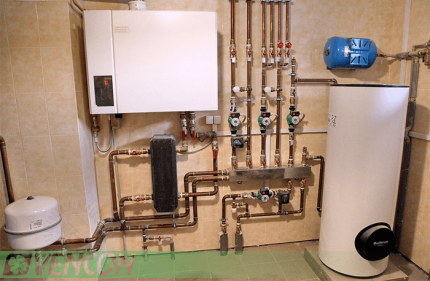
However, by installing such a system, you will ensure long and uninterrupted operation of the equipment throughout the house, as well as be able to control each circuit, up to a complete shutdown, separately.
Scheme # 4 - connection with a flowing boiler
Sometimes the equipment is installed in such a way that all the water heated by the boiler enters immediately into the boiler, and from it the wiring for water supply and heating is already done. At the same time, when someone opens the tap and the pressure in the system drops, it is replenished by supplying cold water to the boiler, together with or in return.
Such a scheme is the simplest. It provides high-quality hot water: water will always be hot, immediately and at the same temperature.
But it has a number of disadvantages:
- Due to the constant flow of water, a boiler that is not designed for this mode of operation will wear out quickly.
- The water temperature in the hot tap will be the same as in the batteries - that is, almost boiling water.
- During the use of large volumes of water, it is possible to lower the air temperature in the house.
A positive point in this decision may be a small amount of additional equipment, as well as low demands on the parameters of the boiler.

When connecting a boiler according to this scheme, do not forget to set the relay to a low temperature or even to a minimum so that the heater does not try to heat the water more than the boiler does.
Otherwise, the heating element will work continuously, providing heating and consuming hundreds of kilowatts of electricity.
Subtleties of installing system components
Having decided on the method of connecting a gas boiler and an electric boiler, you need to carefully think through and draw up a piping diagram, and then proceed with installation.
Stage # 1 - connecting a gas boiler
This stage should be entrusted to professionals: just like any other gas equipment, a gas boiler can only be connected by professionals certified by the gas service.This is due to the fact that even minor errors in installation and configuration are fraught with serious consequences.

If a puddle threatens you during the course of a water supply or sewage system, a maximum of a couple of centimeters of water on the floor, then an error in connecting a gas boiler threatens with fire, explosion or poisoning from combustion products.
We considered the installation schemes of a double-circuit gas boiler in this stuff.
Stage # 2 - boiler installation
An electric boiler working in conjunction with a gas boiler is connected in the same way as in standard use. The only difference is that not cold water is supplied from the water supply, but already hot from the boiler.
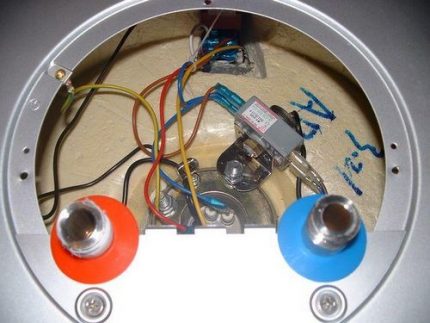
Step-by-step installation instructions for the boiler are described below:
- In the wall, you need to punch two holes under the dowels at the same distance as the boiler mount.
- Then hammer the dowels into the holes, screw the bracket-hooks into them almost all the way, deploy them with hooks straight up. Fasteners are usually included in the boiler kit and are designed for its weight in a state filled with water.
- Hang the tank on the hooks, make sure they fit into the grooves.
- Make water connections to the boiler and faucets using plastic, metal-plastic pipes or flexible hoses. Install a ball valve on each connection for easy boiler maintenance.
- Withdraw a thin tube from the pressure relief valve to the sewer. You can neglect it, but then you will need to tighten the locking screw, provide for a container into which a small amount of water can drain, and check the valve’s efficiency manually every 2 weeks.
- Connect to the mains - this procedure is performed through a dedicated grounded line - a separate cable, stretched from the meter. Regardless of whether the boiler will be plugged into the outlet, or will be connected directly to the cable, you will need to install circuit breaker for extra protection.
- It is also important to take care of high-quality insulation, because the room can be damp.
Installing the boiler and boiler is the main, simplest and most important part of the work, but this is only the beginning. For their effective interaction, it is necessary to complete the binding according to a pre-selected scheme. We will talk about the elements of such schemes below.
Stage # 3 - Connections and Options
The first thing any system connected with water should begin with is installing a filter to clean it.
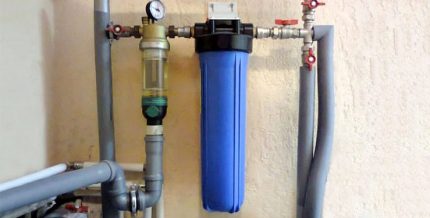
When choosing a filter, remember that the better it will purify the water, the more the boiler, boiler, and all other equipment will last. Otherwise, small particles from the water settle on the walls of the coil and the tank, form scale on the heater's heater, contribute to the destruction of the tank and lead to the rapid failure of all parts of the system - from the boiler to the faucet in the kitchen.
However, choosing the most expensive filter that purifies tap water to a drinking state is also not worth it - it is too expensive and irrational. Filtration systems with 2 to 3 levels of mechanical cleaning of varying degrees, from coarse to fine, will be sufficient.
A filter is installed at the very beginning of the chain, before connecting the water supply to the boiler. Be careful with the direction of flow - it is usually indicated by arrows on the body.
During operation, do not forget to regularly change filter cartridges, otherwise they cease to fulfill their function and may adversely affect the water pressure.
The second obvious and necessary equipment is Ball Valves. There are a lot of them, they are placed on each connection: in front of the filter, at the inlet and outlet of the boiler, on both pipes of the boiler connection, at each branch from the hydraulic arrow, in front of each water tap.
Such a number of cranes ensures safety and comfort of operation. At a certain point, each node in the system will require preventative maintenance, and possibly a replacement, and the ability to disconnect only it will be very important.
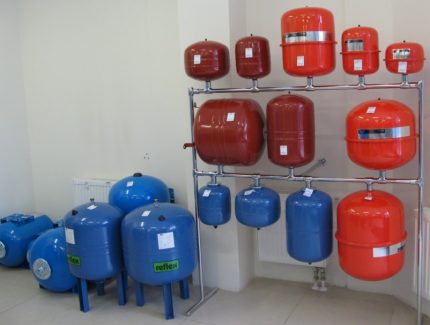
When organizing hot water supply via a boiler, an expansion tank is usually not required: in the event of a critical increase in pressure, the boiler safety valve will operate. But if the heating circuit is removed separately, on it such protection will not be superfluous.
In addition to the listed devices, as well as the hydraulic arrow-comb mentioned above, the pipelines are installed check valvesthat do not allow the flow to reverse even when the pump is turned off, safety and three-way valves, if necessary - pressure reducing valve to reduce pressure.
Alternative DHW solutions through the boiler
As we already mentioned, instead of an electric boiler, hot water supply from a gas boiler can be arranged through an indirect heating boiler.
They come in various structures:
- with a coil-battery inside, from which water is heated;
- tank in the tank, where the internal tank from the water supply is washed and warmed with water from the heating;
- layer-by-layer heating, where cold, hot water and heating return are mixed.
Each of these types has its own characteristics, but they are all more expensive than electric boilers and more bulky.
how connect indirect boiler for hot water to a gas boiler, read a separate article on our website.
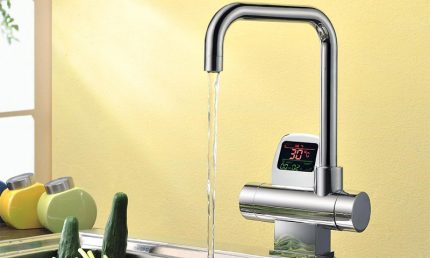
In addition, the problem of temperature differences can be solved by installing mixer with thermostat: It will deliver evenly heated water by mixing with different amounts of cold water. Such a mixer is not cheap, but it is often easier to install it than to re-equip the entire heating system and hot water supply.
Conclusions and useful video on the topic
We have outlined the main options for connecting an electric boiler to a domestic gas boiler, and in order to better present the result, watch the videos on this topic.
Simple diagram and instructions for connecting the boiler to the boiler
And here you can consider the already mounted system:
Thus, connecting the boiler to the double-circuit boiler will make its use more comfortable. In addition, the boiler is able to provide hot water with the simultaneous use of a single-circuit boiler in the heating system.
Equipping a new heating and hot water supply system in your home and want to consult with our experts or other readers regarding the connection of a boiler to a boiler? Do you know other schemes or have you tried one of the suggested ones from your own experience? Join the discussion topic - the feedback block is located below.

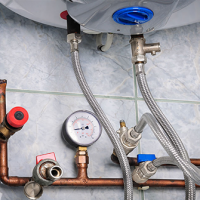 Schemes for connecting a water heater to a water supply system: how not to make mistakes when installing a boiler
Schemes for connecting a water heater to a water supply system: how not to make mistakes when installing a boiler  The layout of the binding of the indirect heating boiler + the rules for its installation and connection
The layout of the binding of the indirect heating boiler + the rules for its installation and connection 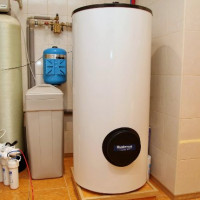 Indirect heating boiler: device, principle of operation and wiring diagrams
Indirect heating boiler: device, principle of operation and wiring diagrams 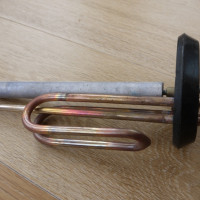 How to change the heater in a water heater: step-by-step instruction of repair work
How to change the heater in a water heater: step-by-step instruction of repair work 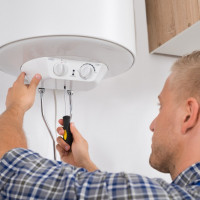 DIY boiler repair: possible malfunctions and instructions for their elimination
DIY boiler repair: possible malfunctions and instructions for their elimination 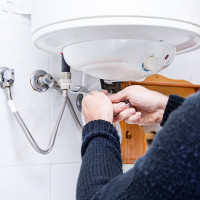 How to drain water from a water heater: the pros and cons of different methods + an example of work
How to drain water from a water heater: the pros and cons of different methods + an example of work  How much does it cost to connect gas to a private house: the price of organizing gas supply
How much does it cost to connect gas to a private house: the price of organizing gas supply  The best washing machines with dryer: model rating and customer tips
The best washing machines with dryer: model rating and customer tips  What is the color temperature of light and the nuances of choosing the temperature of the lamps to suit your needs
What is the color temperature of light and the nuances of choosing the temperature of the lamps to suit your needs  Replacement of a geyser in an apartment: replacement paperwork + basic norms and requirements
Replacement of a geyser in an apartment: replacement paperwork + basic norms and requirements